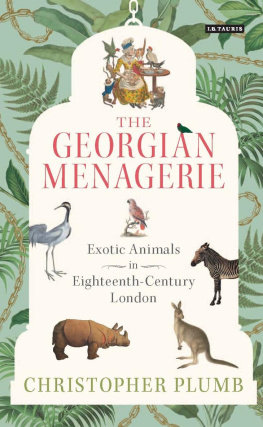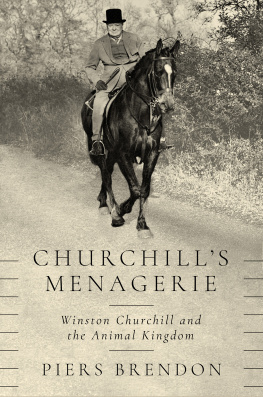Christopher Plumb is an independent historian. He has worked as a television and museum consultant and holds a PhD from the University of Manchester.
From magnificent menageries to an apothecarys pet rodent, Christopher Plumbs book is a fascinating look into the role animals played in eighteenth-century British lives. Full of great primary research into a wealth of interesting records, this is a work to delight the heart of anyone with a love for how the real Georgians lived.
Lucy Inglis, author of Georgian London
Christopher Plumbs entertaining book fills in the detail of a world only vaguely sensed. It appears that the streets of Georgian London were thronged with exotic animals and Plumb shows that these were more fully a part of the Georgian world than has previously been understood. Exotic animals were commodities to be entertained by and to consume. This book adds not only to our growing understanding of the surprisingly large-scale presence of exotic animals in England since the Renaissance but also to our grasp on the textures of life in the always fascinating streets, inns and drawing rooms of Georgian London.
John Simons, author of The Tiger That Swallowed the Boy: Exotic Animals in Victorian England
The G eorgian M enagerie
Exotic Animals in Eighteenth-Century London
Christopher Plumb
Published in 2015 by
I.B.Tauris & Co. Ltd
London New York
www.ibtauris.com
Copyright 2015 Christopher Plumb
The right of Christopher Plumb to be identified as the author of this work has been asserted by the author in accordance with the Copyright, Designs and Patents Act 1988.
All rights reserved. Except for brief quotations in a review, this book, or any part thereof, may not be reproduced, stored in or introduced into a retrieval system, or transmitted, in any form or by any means, electronic, mechanical, photocopying, recording or otherwise, without the prior written permission of the publisher.
Every attempt has been made to gain permission for the use of the images in this book. Any omissions will be rectified in future editions.
References to websites were correct at the time of writing.
ISBN: 978 1 78453 084 6
eISBN: 978 0 85773 928 5
A full CIP record for this book is available from the British Library
A full CIP record is available from the Library of Congress
Library of Congress Catalog Card Number: available
Typeset by JCS Publishing Services Ltd, www.jcs-publishing.co.uk
Contents
List of Illustrations
Acknowledgements
Prologue
Introduction
Part I: TRADE
1 Buy a Fine Singing Bird
2 To Be Seen or Sold
3 The Property of
Part II: INGREDIENTS
4 Turtle Travels Far
5 Bear Grease for your Powdered Wig
6 The Product of the Civets Posteriors
Part III: CROWDS
7 Ladies and Gentlemen
8 Bitten, Crushed and Maimed
9 Sweet Camels Breath
10 Exotic Estates
11 John Bull and Happy Britain
12 Llamas Spit, a Pot of Barclays Entire and Elephant Chops
13 Under the Knife
Part IV: HUMOUR
14 Electric Desire
15 The Queens Ass
16 The Love Birds
Epilogue
Note on Archives
Notes
Further Reading
Illustrations
Seaman Holding a Monkey , 1816, Joshua Cristall (17681847), watercolour and graphite, Yale Center for British Art, Paul Mellon Collection
A Bear , James Sowerby (17561822), graphite, Yale Center for British Art, Paul Mellon Collection
Study of a Bear , Sawrey Gilpin (17331807), graphite, Yale Center for British Art, Paul Mellon Collection
A Kangaroo , James Sowerby (17561822), watercolour and gouache, Yale Center for British Art, Paul Mellon Collection
A Lion , James Sowerby (17561822), graphite, Yale Center for British Art, Paul Mellon Collection
Rhinoceros , 1790, George Stubbs (17241806), commissioned by John Hunter, oil on canvas, Royal College of Surgeons of London
Study of an Elephant , Sawrey Gilpin (17331807), graphite, Yale Center for British Art, Paul Mellon Collection
Zebra , 1763, George Stubbs (17241806), oil on canvas, Yale Center for British Art, Paul Mellon Collection
Susanna Highmore , c .17405, Joseph Highmore, oil on canvas, National Gallery of Victoria, Melborne. Felton Bequest, 1947
A Maiden Lady and her Family , c .182040, Orlando Hodgson, watercolour lithograph, Yale Center for British Art, Paul Mellon Collection
Guinea Parrot , 1736, George Edwards (16941773), watercolour, gouache and graphite, Yale Center for British Art, Paul Mellon Collection
A Crane , 1791, William Hayes (172999), watercolour, gouache, ink and graphite, Yale Center for British Art, Paul Mellon Collection
Acknowledgements
I would like to thank both my editor at I.B.Tauris, Joanna Godfrey, and my agent Kirsty McLachlan for their invaluable advice and assistance; by their hands, an unruly beast of a manuscript was tamed into a book.
The roots of this book lie in a doctoral thesis supervised by Samuel Alberti and the late John Pickstone. As they pruned my academic writing of a surfeit of eighteenth-century animal anecdotes, I was always told with encouragement to save it for the book. In the later stages Helen Rees Leahy and Charlotte Sleigh helped shape the thesis in its final form as doctoral examiners. The doctoral research was supported financially by the Arts and Humanities Research Council UK and the Max-Planck-Gessellschaft, Germany.
This book would have been impossible without access to archival material and primary sources. Mike Rendell very kindly shared the diaries of Richard Hall, his great-great-great-grandfather. Jean Smiter-Brookes, descendant of the bird and animal merchant Joshua Brookes, generously shared the fruits of her research into her family history. I would also like to express sincere gratitude to the staff of the Bodleian Library, the British Library, the British Museum, the London Metropolitan Archives, the National Records Office, the Royal College of Surgeons, London, the National Gallery of Victoria and the Yale Center for British Art.
Some sections of this book have been adapted in part from some of my previously published academic research. Permission to republish has been granted from the following rights holders:
Elsevier for The Electric Stroke and the Electric Spark: Anatomists and Eroticism at George Bakers Electric Eel Exhibition in 1776 and 1777, Endeavour xxxiv/3 (2010), pp. 8794.
Maney Publishing for In Fact One Cannot See it Without Laughing: The Spectacle of the Kangaroo in London, 17701830, Museum History Journal iii/1 (2010), pp. 732.
Wiley and Sons for Strange and Wonderful: Encountering the Elephant in Britain, 16751830, Journal for Eighteenth-Century Studies xxxiii/4 (2010), pp. 52543.
University of Virginia Press for The Queens Ass: The Cultural Life of Queen Charlottes Zebra in Georgian Britain, in Samuel Alberti (ed.), The Afterlife of Animals (2011), pp. 1736.
Prologue
R ichard Hall (17291801) was a haberdasher, and had a parrot called Polly. His diaries recorded the times when Polly was unwell, when she got better Polly much recovered and the time that Polly went away. Hall kept her cage; an inventory in 1794 recorded it as stored in a backroom among clotheshorses and sundry boxes.








